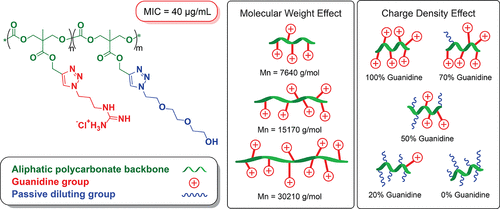当前位置:
X-MOL 学术
›
Biomacromolecules
›
论文详情
Our official English website, www.x-mol.net, welcomes your
feedback! (Note: you will need to create a separate account there.)
Molecular Weight and Charge Density Effects of Guanidinylated Biodegradable Polycarbonates on Antimicrobial Activity and Selectivity
Biomacromolecules ( IF 5.5 ) Pub Date : 2017-11-21 00:00:00 , DOI: 10.1021/acs.biomac.7b01245 Chloe A Hae Cho , Chao Liang , Janesha Perera , Jie Liu , Kyriakos G. Varnava , Vijayalekshmi Sarojini , Ralph P. Cooney , Duncan J. McGillivray , Margaret A. Brimble , Simon Swift , Jianyong Jin
Biomacromolecules ( IF 5.5 ) Pub Date : 2017-11-21 00:00:00 , DOI: 10.1021/acs.biomac.7b01245 Chloe A Hae Cho , Chao Liang , Janesha Perera , Jie Liu , Kyriakos G. Varnava , Vijayalekshmi Sarojini , Ralph P. Cooney , Duncan J. McGillivray , Margaret A. Brimble , Simon Swift , Jianyong Jin

|
Six guanidine functionalized aliphatic biodegradable polycarbonates with varying molecular weights and charge densities were synthesized via postsynthesis modification of alkyne containing polycarbonates using Cu(I)-catalyzed azide–alkyne cycloaddition (CuAAC) click chemistry. The concept of passive diluting group was to modify the cationic charge density of the polycarbonate without changing its hydrophilicity. Within the molecular weight range from 8000 to 30000 g mol–1, these guanidine polycarbonates exhibited broad-spectrum biocidal activity with low toxicity to red blood cells (RBCs). The lowest molecular weight homopolymer sample (PG-8k-100) showed the best antimicrobial activity (MIC = 40 μg/mL against Escherichia coli and MIC = 20 μg/mL against Staphylococcus epidermidis) and least RBC toxicity (0.6% hemolysis at MIC). Within the three guanidine charge densities from 20% to 70%, the low to medium dilution samples (PG-8k-7030 and PG-8k-5050) had no obvious loss in antimicrobial activities compared to the nondiluted control sample PG-8k-100. However, upon further dilution, PG-8k-2080 gave the lowest antimicrobial activity.
中文翻译:

胍基化生物可降解聚碳酸酯的分子量和电荷密度对其抗菌活性和选择性的影响
通过使用Cu(I)催化的叠氮化物-炔烃环加成(CuAAC)点击化学反应,对含炔烃的聚碳酸酯进行后合成修饰,合成了六种具有不同分子量和电荷密度的胍官能化的脂肪族生物可降解聚碳酸酯。被动稀释基团的概念是在不改变其亲水性的情况下改变聚碳酸酯的阳离子电荷密度。在8000至30000 g mol –1的分子量范围内,这些胍基聚碳酸酯表现出广谱的杀菌活性,对红细胞(RBC)的毒性低。分子量最低的均聚物样品(PG-8k-100)表现出最佳的抗菌活性(MIC = 40μg/ mL,对大肠杆菌,MIC = 20μg/ mL,对大肠杆菌表皮葡萄球菌)和RBC毒性最小(MIC溶血0.6%)。在20%至70%的三种胍电荷密度范围内,与未稀释的对照样品PG-8k-100相比,中低稀释度样品(PG-8k-7030和PG-8k-5050)的抗菌活性没有明显降低。 。但是,进一步稀释后,PG-8k-2080的抗菌活性最低。
更新日期:2017-11-22
中文翻译:

胍基化生物可降解聚碳酸酯的分子量和电荷密度对其抗菌活性和选择性的影响
通过使用Cu(I)催化的叠氮化物-炔烃环加成(CuAAC)点击化学反应,对含炔烃的聚碳酸酯进行后合成修饰,合成了六种具有不同分子量和电荷密度的胍官能化的脂肪族生物可降解聚碳酸酯。被动稀释基团的概念是在不改变其亲水性的情况下改变聚碳酸酯的阳离子电荷密度。在8000至30000 g mol –1的分子量范围内,这些胍基聚碳酸酯表现出广谱的杀菌活性,对红细胞(RBC)的毒性低。分子量最低的均聚物样品(PG-8k-100)表现出最佳的抗菌活性(MIC = 40μg/ mL,对大肠杆菌,MIC = 20μg/ mL,对大肠杆菌表皮葡萄球菌)和RBC毒性最小(MIC溶血0.6%)。在20%至70%的三种胍电荷密度范围内,与未稀释的对照样品PG-8k-100相比,中低稀释度样品(PG-8k-7030和PG-8k-5050)的抗菌活性没有明显降低。 。但是,进一步稀释后,PG-8k-2080的抗菌活性最低。











































 京公网安备 11010802027423号
京公网安备 11010802027423号